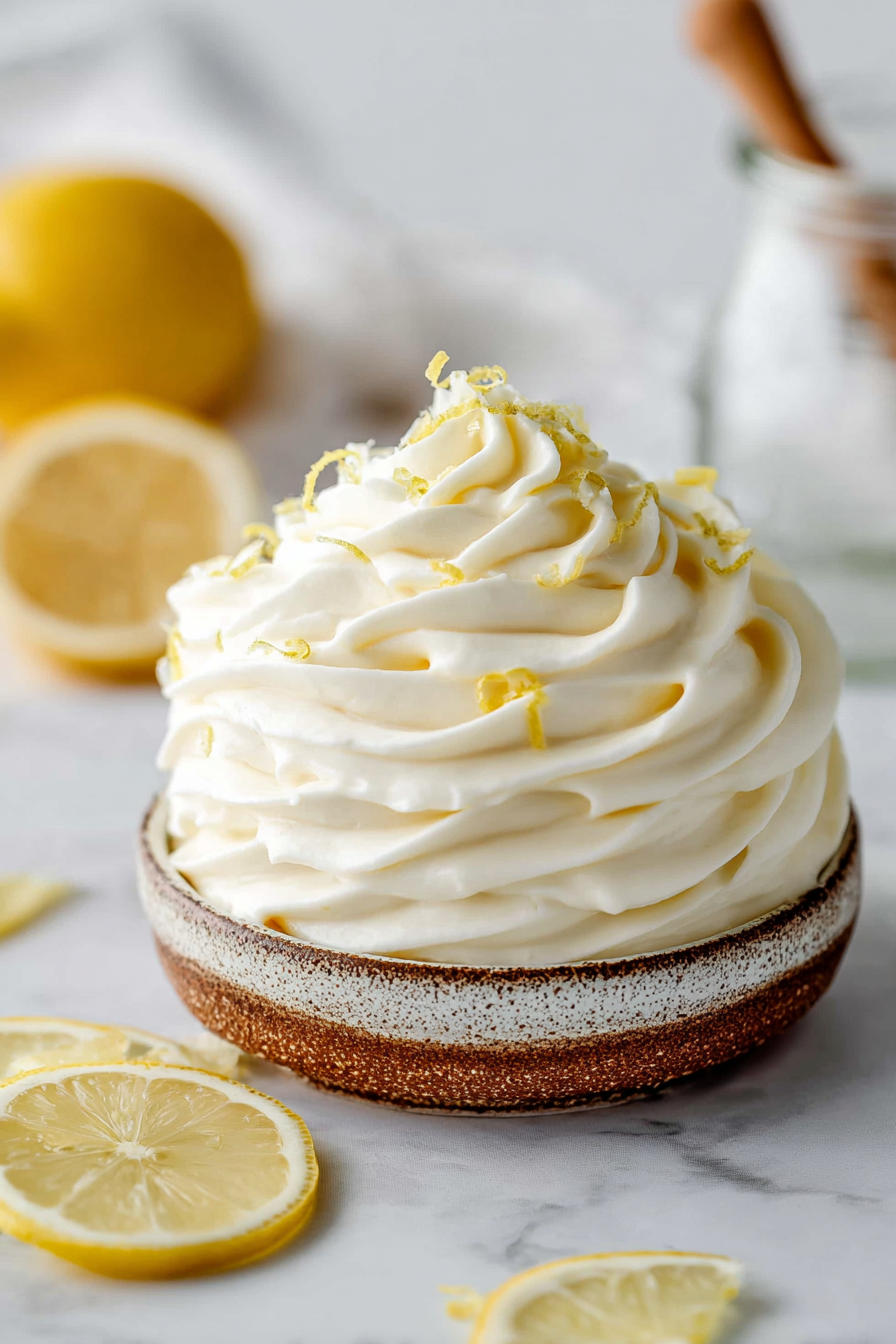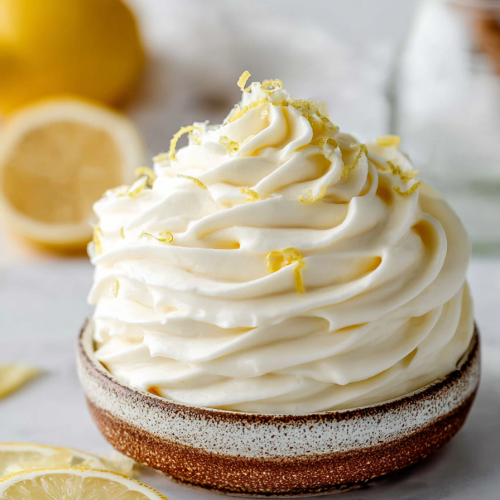Delish Lemon Ermine Frosting Recipes

This lemon ermine frosting is the kind of thing that makes people raise their eyebrows and ask if it’s really frosting—it’s unbelievably light, silky, and bright with fresh lemon, but without the heavy sweetness of traditional buttercream. It’s built on a cooked flour-and-milk paste (the “ermine” base) that’s cooled and then whipped with butter and lemon zest/juice until cloudlike. If you want a frosting that tastes like sunshine on a cake but doesn’t overwhelm the crumb, this is it.
My little family eats this one with no ceremony: my husband will literally scrape the bowl with a spoon while I pack away leftovers, and my kids request it on birthdays because it doesn’t glue your face together like too-sweet frostings do. It’s become our go-to when I want something that feels special but isn’t fussy—easy enough for a weeknight bake, elegant enough for company. The first time I made it, I thought I’d messed up when the cooked paste looked odd, but patience and a good whisk turned it into the most tender frosting we’ve ever had.
Why You’ll Love This Delish Lemon Ermine Frosting Recipes
– It’s remarkably light: the cooked flour base gives structure without heaviness, so the frosting feels airy rather than dense.
– Bright lemon flavor: fresh zest and a touch of juice cut through the richness for a clean, refreshing finish.
– Less sweet than buttercream: perfect if you like balance and want the cake’s flavor to shine.
– Versatile texture: spreads smoothly on layer cakes, pipes beautifully for cupcakes, and pairs with fruit-filled cakes or simple vanilla sponges.
Behind the Recipe
This frosting is honest work: you cook a flour-and-milk paste, cool it completely, then whip it together with softened butter and lemon until it’s fluffy. From making it at home dozens of times, I’ve learned the two crucial things are temperature and timing—if the paste is too warm, the butter melts; too cold, and the mixture can be stubborn to smooth out. Also, use real lemon zest and a little juice for brightness; bottled juice lacks the aromatic oils the zest provides. Little touches that make it shine: a pinch of fine sea salt to round the flavor and a splash of vanilla for depth.
Shopping Tips
– Baking Basics (Flour/Sugar/Leaveners): All-purpose flour is what you need for the cooked paste—measure by spooning into the cup or weigh for accuracy to avoid a gummy paste.
– Dairy: Full-fat milk and real butter give the best texture and mouthfeel; avoid low-fat milk as it can make the base thinner.
– Eggs: Not required for the ermine base itself, but if you’re pairing with a cake, use fresh eggs for structure and color.
– Citrus: Choose firm, fragrant lemons—Meyer lemons are sweeter and more floral if you want a softer lemon note, while Eureka or Lisbon lemons give a bright, classic tang.
– Fats & Oils: Use real unsalted butter so you control the salt level; if using salted butter, cut back on any additional salt called for.
Prep Ahead Ideas
– Make the cooked flour-and-milk paste a day ahead and chill it; having it fully cold makes whipping faster and more reliable.
– Zest lemons ahead and store the zest in a small airtight container in the fridge for a day.
– Soften butter on the counter or use the gentle microwave-soften trick just before you plan to whip so everything comes together smoothly.
– Store the cooked base in the fridge for up to 48 hours in a covered container; bring it to cool-but-not-warm temperature before whipping.
Time-Saving Tricks
– Use a stand mixer with the whisk attachment to get the frosting light and airy with less elbow grease.
– Heat milk in the microwave in short bursts instead of a stovetop to speed up the roux step—stir constantly and watch carefully.
– Have your butter at a consistent softened temperature by setting it out an hour before or softening in 5–10 second microwave bursts.
– Prep mise en place: zest, measure flour, and have milk warmed and ready to avoid interruptions during the cook step.
Common Mistakes
– Overheating or undercooking the flour paste: if it’s too thin you’ll get a loose frosting, too thick and it can be pasty; aim for a pudding-like consistency. If it’s off, gently adjust by simmering a little longer or whisking in a touch more milk.
– Adding butter when the base is too warm: the butter will melt and the frosting will be greasy—always cool the base to near room temp before whipping.
– Overwhipping after the butter is added: it can become grainy or split; if that happens, chill briefly and then gently rewhip.
– Rushing the chill or temperature steps: patience here prevents separation and yields the best texture.
What to Serve It With
Tips & Mistakes
Serve this frosting on simple vanilla or almond cakes, lemon layer cakes, angel food cake, or light sponge cakes. It’s excellent with berry fillings—strawberries, raspberries, or blueberry compotes match the lemon perfectly. A common mistake is pairing it with an overly dense cake; stick to lighter, tender crumbs so the frosting’s airiness can complement the dessert.
Storage Tips
Store in airtight containers in the fridge. It reheats beautifully, but if you sneak a bite cold straight from the container, it still works.
Variations and Substitutions
– Swap some lemon for lime or orange zest and juice for a citrus twist, but keep proportions small so the frosting’s structure isn’t affected.
– For a creamier tang, fold in a small amount of cream cheese at the end—this changes the texture and keeps longer in the fridge.
– To make it slightly sweeter without losing the ermine character, add a touch of sifted powdered sugar while whipping, but add sparingly.
– For gluten-free versions, try a 1:1 gluten-free flour blend that includes xanthan gum; results vary, so test a small batch first.

Write me the frequently asked questions and answers Delish Lemon Ermine Frosting Recipes in the same way as the example below.
Frequently Asked Questions

Delish Lemon Ermine Frosting Recipes
Ingredients
Main Ingredients
- 1 cup whole milk Use fresh milk for the best results.
- 0.25 cup all-purpose flour Sifted flour works well here.
- 0.75 cup granulated sugar
- 0.5 cup unsalted butter Make sure it's softened to room temperature.
- 1 tbsp fresh lemon juice For a brighter flavor, fresh juice is best.
- 1 tbsp lemon zest Adds a nice fragrant touch.
- 1 tsp vanilla extract
Instructions
Preparation Steps
- In a medium saucepan, whisk together the milk and flour over medium heat. Cook, stirring constantly, until thick and bubbly, about 10 minutes. Remove from heat and let it cool.
- In a large bowl, beat together the sugar and butter until it’s light and fluffy. This should take about 3 minutes.
- Once the milk mixture has cooled, add it to the butter and sugar mixture, along with the lemon juice, lemon zest, and vanilla extract. Beat until thoroughly combined and smooth.
- Use this delicious frosting to generously decorate your favorite cakes or cupcakes. Enjoy the zesty delight!
